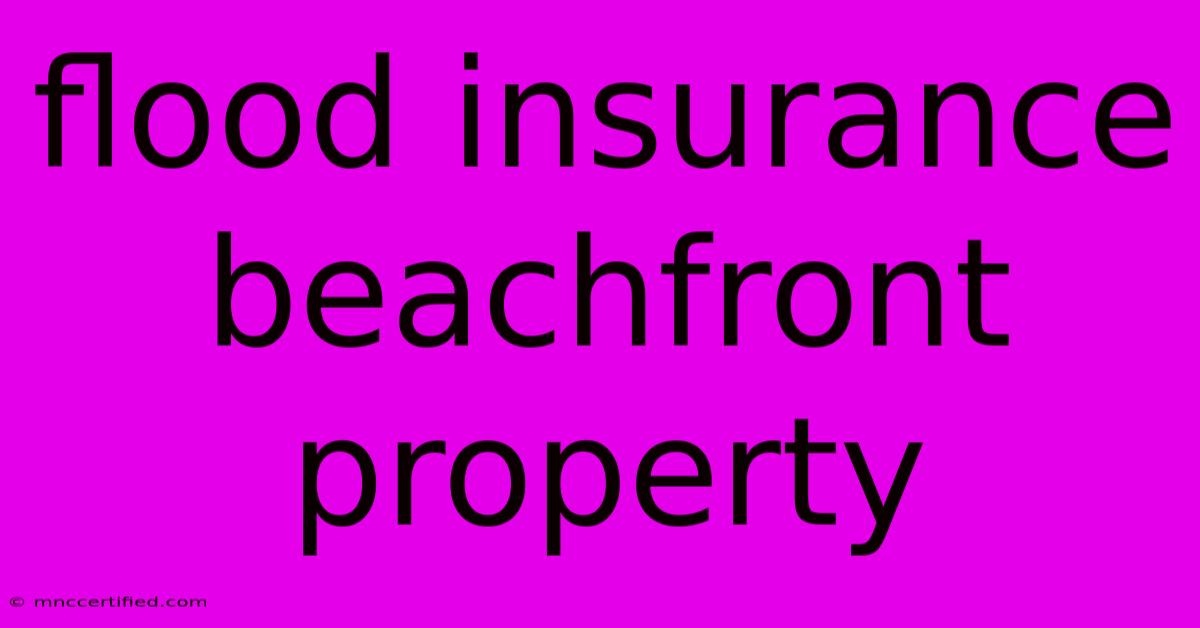Flood Insurance Beachfront Property

Table of Contents
Navigating the Waters: Flood Insurance for Beachfront Property
Living by the sea is a dream for many, but the allure of beachfront property comes with a crucial consideration: flood risk. While the ocean's beauty is undeniable, its power can be devastating, especially when storms surge and tides rise. This is where flood insurance becomes a vital safety net, protecting your investment and your peace of mind.
Why Is Flood Insurance Essential for Beachfront Properties?
Beachfront homes are inherently more susceptible to flooding than inland properties. Here's why:
- Coastal Storms: Hurricanes, tropical storms, and even severe winter storms can bring heavy rainfall and storm surges, pushing seawater inland and flooding coastal areas.
- Sea Level Rise: Climate change is causing sea levels to rise, increasing the frequency and intensity of coastal flooding events.
- Tidal Surge: High tides, especially during full or new moons, can exacerbate flooding, especially in areas with low-lying elevation.
Understanding the Different Types of Flood Insurance
Flood insurance comes in two main forms:
1. National Flood Insurance Program (NFIP): This government-backed program offers flood insurance to homeowners and renters in participating communities. It is the most widely available and affordable option.
2. Private Flood Insurance: Several private insurers offer flood insurance policies, often providing more coverage options and potentially lower premiums for high-value properties.
Factors Affecting Flood Insurance Premiums
Your beachfront property's flood insurance premium will be calculated based on several factors:
- Location: Your property's proximity to the coastline, elevation, and flood zone designation all play a major role.
- Property Value: The higher the value of your home, the more expensive your flood insurance premiums may be.
- Flood Risk: Areas with a higher historical risk of flooding will typically have higher premiums.
- Flood Mitigation Measures: Installing flood mitigation features like elevating your home or using flood-resistant materials can help reduce your premium.
Essential Tips for Securing Flood Insurance
- Check Your Flood Zone: Determine your property's flood zone designation through FEMA's Flood Map Service. This will give you an understanding of your flood risk.
- Compare Policies: Get quotes from multiple insurers, both NFIP and private, to compare coverage options and premiums.
- Understand the Fine Print: Carefully review your policy's terms and conditions, including deductibles, coverage limits, and exclusions.
- Consider Flood Mitigation: Invest in flood mitigation measures to reduce your flood risk and potentially lower your premiums.
- Stay Updated: Stay informed about changing flood risks and potential updates to flood zone designations, as these can impact your insurance needs.
Navigating the Waters with Confidence
While beachfront property ownership comes with inherent risks, understanding flood insurance and taking proactive steps can give you peace of mind. By carefully considering your options, securing appropriate coverage, and implementing flood mitigation measures, you can navigate the waters with confidence and enjoy the beauty of coastal living for years to come.

Thank you for visiting our website wich cover about Flood Insurance Beachfront Property. We hope the information provided has been useful to you. Feel free to contact us if you have any questions or need further assistance. See you next time and dont miss to bookmark.
Featured Posts
-
Skai Jackson Shares Pregnancy News Disney Channel Star
Nov 13, 2024
-
Denzel Washingtons Last Movie Black Panther 3
Nov 13, 2024
-
Recent M2 0 Earthquake At Mt Gareloi
Nov 13, 2024
-
Certificate Of Insurance For Moving
Nov 13, 2024
-
Martin Lewis Car Finance Cashback Now
Nov 13, 2024